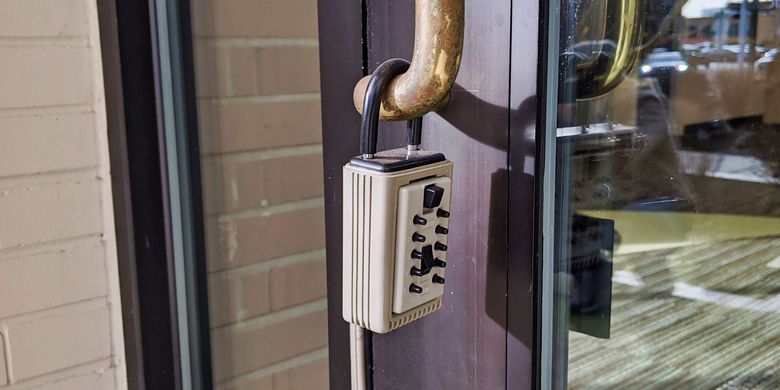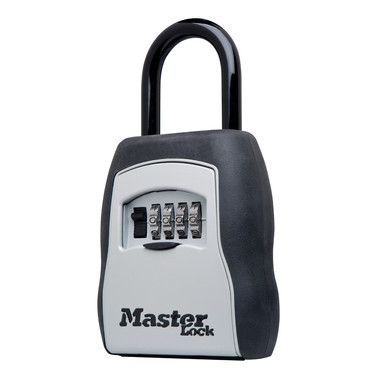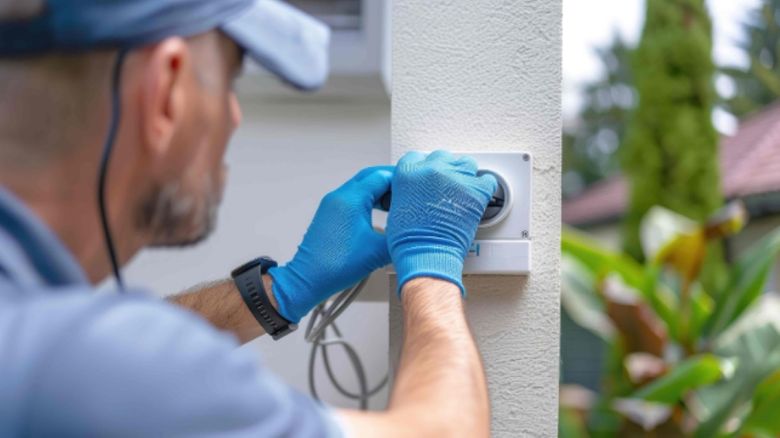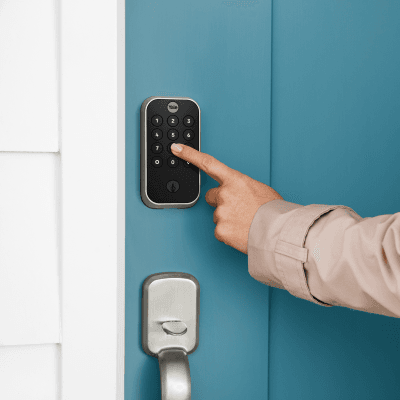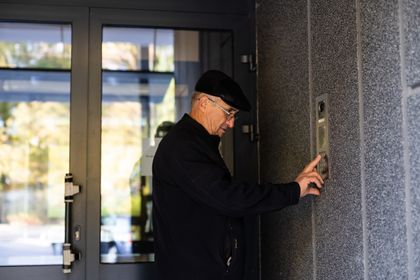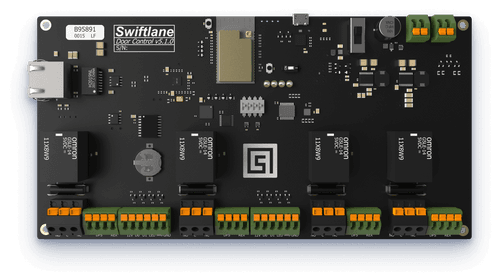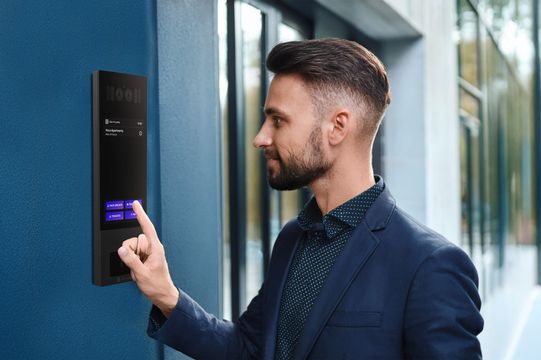Article Updated on May 6th, 2025
You’re away from home on a business trip when you remember that you didn’t leave a key for the plumber scheduled to fix that leaking pipe. Or perhaps you’re an Airbnb host managing multiple properties across town, with guests arriving unexpectedly. These everyday challenges, which require you to be physically present everywhere all at once, have a simple solution: key lock boxes.
For property managers and homeowners, these small, secure containers mounted outside properties help to transfer physical access when you can’t be present.
But with property crimes evolving with increasing porch piracy, the question becomes increasingly complex: Should the key lock box still have a place in your security strategy?
This article outlines the capabilities of key lock boxes, potential risks, and how they compare to modern security alternatives.
Suggested Posts:
- The Best Apartment Intercom Systems (2025)
- Biometric Access Control: What It Is and Why You Need It
- Cheap Intercom System for Residential and Commercial Uses
Table of Contents
- Understanding Key Lock Boxes
- Common Uses for Key Lock Boxes
- Types of Key Lock Boxes
- Choosing a Key Lock Box in 2025: Key Considerations
- Expert Recommendations for Making Your Key Lock Box More Secure
- Beyond Lock Boxes: Modern Alternatives Worth Considering
- Swiftlane as a Key Lock Box Alternative
- The Bottom Line: Are Key Lock Boxes Safe ?
- Frequently Asked Questions
Understanding Key Lock Boxes
Key lock boxes are storage devices specifically designed for keys. They are commonly used in context of providing guest access, facilitating real estate transactions, and addressing emergency situations by storing spare keys in a secure manner. However, not all key lock boxes are created equal, and it is essential to understand the differences in design, materials, and security features to make an informed decision.
Common Uses for Key Lock Boxes
Key lock boxes are primarily used to grant access and monitor access events for various use cases.
- In the case of Airbnb rentals, lockboxes are utilized to provide guests with a contactless, self-check-in experience, which eliminates the need for hosts to be physically present.
- In commercial and residential settings, realtors and landlords benefit from lockboxes to manage property access and streamline operations.
- For businesses that require consolidated storage for extra keys, such as car repair shops, sales offices, and rental properties, key lock boxes are again an ideal solution.
Overall, the best key lock boxes offer a versatile and secure method for safekeeping of keys and facilitating access to properties. When considering options for key lock boxes, it’s important to compare their features and security levels to ensure you make the right choice for your needs.
Let’s explore the different types of key lock boxes.
Types of Key Lock Boxes
There are primarily two types of key lock boxes that you can consider for your property in 2025. Each type offers distinct advantages and security profiles to meet different needs.
1. Mechanical Combination Lock Boxes
What they are: These lock boxes are more traditionally designed as they require you to arrange a numeric combination on rotating dials or push buttons in order for the lock to open. Made with robust metal (usually), they have a spacious compartment that can hold several keys or a bunch.
Key features:
- No batteries or power source required
- Weather-resistant construction (in higher-quality models)
- Available in wall-mount, door-hanging, or portable configurations
- Combination lengths typically range from 4 to 10 digits
- Some newer models offer resettable combinations
Best for:
- Occasional access needs (contractor visits, emergency access)
- Budget-conscious users
- Situations where technology isn’t reliable (areas with poor connectivity)
- Locations where extreme temperatures might affect electronic components
- Users who prefer mechanical simplicity over technological features
We consider combination lock boxes as low-security entry-level solutions. While they are relatively affordable and require no power, they’re also the most vulnerable to physical attacks because they’re only defense is the metal they’re made of.
Recent models from brands like Master Lock and Kidde incorporate special alloys that resist cutting and drilling, which is an improvement over primitive padlocks.
2. Bluetooth/Wi-Fi Enabled Smart Lock Boxes
What they are: These are new-generation key lock boxes that connect to your smartphone via Bluetooth or Wi-Fi and help you control the lock box from anywhere using your linked mobile device. Bluetooth-enabled options require proximity, while Wi-Fi-based options can work from anywhere as long as you have a stable connection.
The biggest advantage of these models is remote access control and modern infrastructure, as they typically feature digital keypads or touchscreens.
Key features:
- Remote access management through dedicated mobile apps
- Customizable access schedules (time-based permissions)
- Temporary access codes with automatic expiration
- Real-time notifications and detailed access logs
- Integration with smart home ecosystems (Amazon Alexa, Google Home)
- Battery-powered with low-battery alerts
- Advanced models include tamper alerts that notify you of unauthorized access attempts
Best for:
- Vacation rental hosts managing multiple guests
- Property managers overseeing multiple properties
- Homeowners who need to grant temporary access to visitors
- Anyone who wants detailed records of who accessed their property and when
There has been a significant advancement in these types of lock boxes since 2023, including the addition of anti-tampering features like weather sealing and motion sensors. Although more expensive than mechanical combination lock boxes, these newer models also offer better security through encryption protocols.
Choosing a Key Lock Box in 2025: Key Considerations
There are some pivotal factors that you must keep in mind while shopping for a key lock box in 2025, which can make or break your property’s security system. Analyze the durability of construction material, type of lock mechanism, and the potential vulnerabilities it might be exposed to before narrowing down on an option.
Let’s discuss these key considerations in detail.
Material and Construction
How secure your physical key truly is depends largely on the durability of its container.. Forced entry methods, such as lock picking, the use of a bump key, or employing a crowbar, can bypass the security features of a key lock box, compromising its ability to protect your property. Vandals and porch pirates also resort to drilling, prying, cutting, decoding, and shimming, the tools for which are easily available at any hardware store. These acts compromise your property within minutes.
When you select a key lock box with a high vandal resistance rating, you ensure that your lock box will be able to withstand such forced entry attempts and protect the keys stored inside.
Lock Mechanisms
The type of lock mechanisms employed in key lock boxes plays a significant role in their overall security. Single-cylinder, double-cylinder, and single-cylinder with a thumb turn are some of the lock mechanisms used in key lock boxes. These locks can be unlocked with either a combination lock or a PIN code.
Although choosing a new-age security mechanism like Bluetooth/ Wi-Fi enabled lock does not guarantee 100% security as it can also be intercepted, it is a relatively safer option compared to combination locks, where “code harvesting” (fingerprints or wear patterns reveal the combination) is rampant.
Environmental Factors
Environmental factors can also affect the security and functionality of key lock boxes. Extreme temperatures, humidity, and snow can cause corrosion of the metal components of key lock boxes, making them more susceptible to breaking.
These risks call for an IP65-rated device that provides the highest resistance to extreme temperatures and weather conditions.
Digital Vulnerabilities (What Manufacturers Won’t Tell You)
As key lock boxes grow smarter, they bring along an entirely new category of security concerns that traditional models do not face.
Today, it is possible to intercept Bluetooth signals to capture access codes or authentication tokens (Bluetooth sniffing).
One can also leverage weak network security, easy-to-guess passcodes, poor maintenance, and irregular device servicing to gain control of a key lock box if it is managed over a Wi-Fi network.
If your key lock box is ultra-modern and depends on cloud service for storage or monitoring of audit logs, it becomes vulnerable during data breaches at the service provider level or during power outages.
Expert Recommendations for Making Your Key Lock Box More Secure
Strategic Placement
As part of strategic key lock box placement, you must choose a location that is discreet and not easily visible to passersby. If you place the key lock box right next to the door, it becomes obvious that it is some access credential, exposing it to vulnerabilities.
A secure mount on a wall or other solid surface is equally important as it will ensure sturdy attachment and eliminate any risk of intruders pulling out the entire frame altogether. For best results, use heavy metal bolts or specialized mounting hardware.
Regular Maintenance and Code Updates
To ensure consistent security, you must:
- Change the access codes periodically.
- Inspect the lock mechanism for any indications of wear and tear or tampering.
- Clean mechanical components to prevent dust accumulation or jamming.
- Update the firmware on smart key lock boxes to patch security gaps.
- Ensure that the box is securely affixed to a wall or other surface.
Follow Best Practices
For optimal results, we recommend creating a layered security system of which the key lock box is just one part. Add a video intercom or smart lock to your property for multi-level protection and to ensure you have other systems to depend on in case one fails.
Conversely, it is also advised to only store keys to less-value areas or spaces. For high-risk areas, it’s best not to opt for metallic keys but go for something that is more specific and hard to penetrate, such as a biometric access control system or a 2-way video intercom system.
Beyond Lock Boxes: Modern Alternatives Worth Considering
While you can always choose key lock boxes as a convenient and secure method for storing keys, there are alternative access management solutions that provide modern security features and benefits.
Smart locks and video intercom systems are some such options, which create a customized access control system for your property and provide you with a modern feature bundle that’s equipped to manage new-age issues of 2025.
Let’s explore how these devices can serve your property better.
Smart Locks
Smart locks are modern door locks that replace traditional mechanical locks with electronic systems. These locks eliminate the need for physical keys. They allow users to unlock doors using digital credentials, such as a smartphone app or entering a PIN code on a keypad or touchscreen.
Property managers can enjoy all the advantages of lockboxes, including self-check-ins and contactless property access, while avoiding potential issues such as misplaced keys, forgotten passwords, and susceptibility to mechanical intrusion.
Yale Assure Lock 2
Yale, a leading provider of regular and smart locks, offers multiple such options from which we recommend Yale’s Assure Lock 2 series.
These smart locks can be used as standalone devices for entry or in-unit doors, or can be integrated with an access control system, such as Swiftlane. We recommend integration with access systems due to the combined benefits and a unified access experience.
Yale smart locks are simple to install and set up, requiring just a screwdriver and a stable internet connection. You also have a slot for your physical key as backup. They make your property’s security more robust through the following features:
- Keyless entry using one-time or permanent PINs/ mobile app
- Easy visitor and guest access
- Remote access and monitoring from anywhere
- Easy-to-use interface for access management
- Smooth integration with existing property management systems
Video Intercom Systems
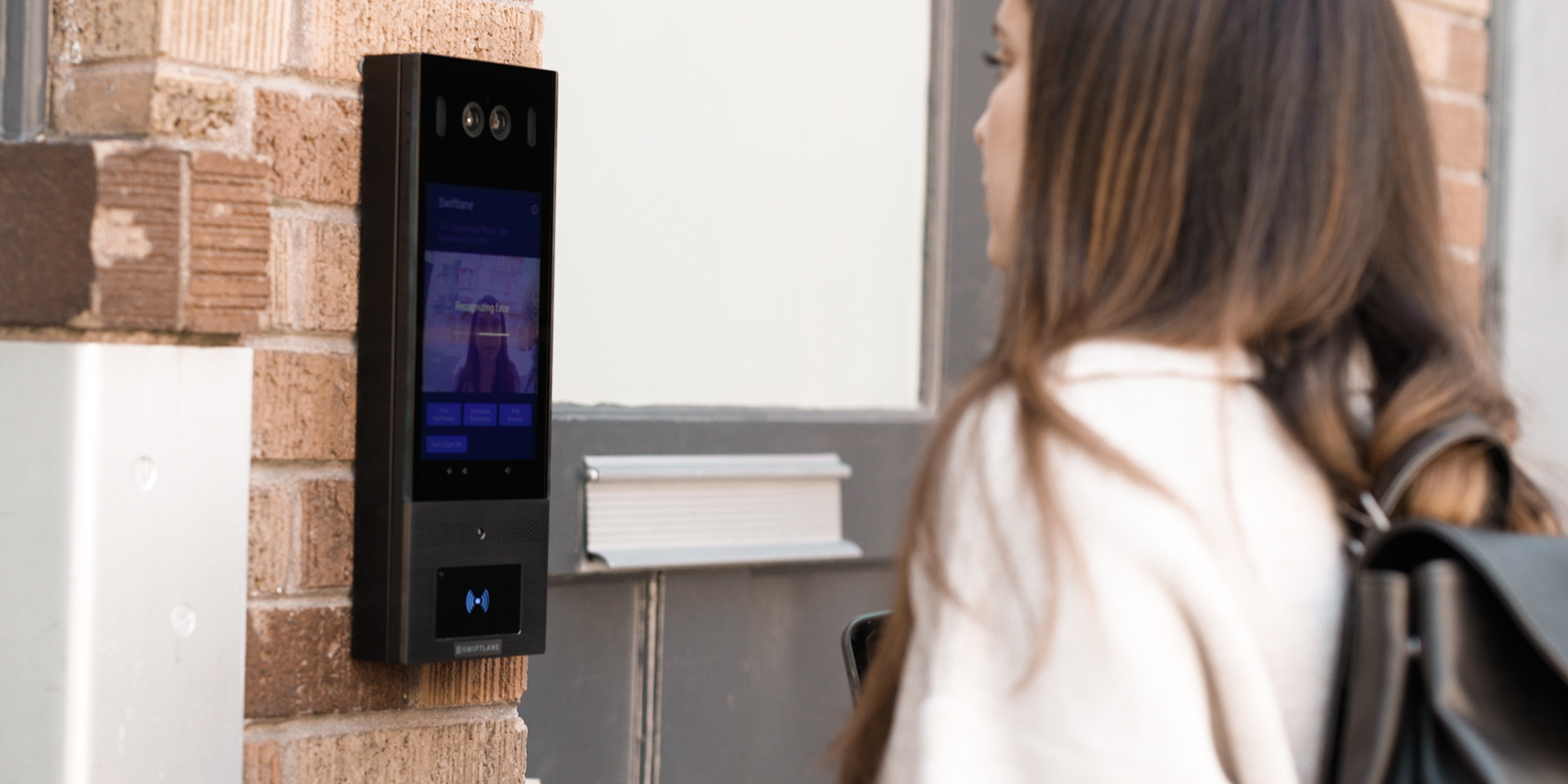
Video Intercom systems, especially those that provide two-way video calling capability, offer exceptional security by enabling video verification of visitors. There are significant feature bundles.
Video intercom systems offer a secure alternative to key lock boxes, providing remote access control and monitoring for enhanced security. These systems can be particularly advantageous in situations where it is not feasible or desirable to provide physical keys. Examples include vacation rental properties or large apartment complexes.
By integrating a video intercom system with your access control system, you can benefit from:
- Increased security and convenience
- Ensuring that only authorized individuals are granted access to your property
- Preventing unauthorized access, theft, and damage
- Providing greater peace of mind and control over your property.
Swiftlane as a Key Lock Box Alternative
Swiftlane’s cloud-based access control system offers several advantages over traditional key lock boxes:
- Enhanced security: By eliminating the need for physical keys, the risk of unauthorized access due to lost or stolen keys is significantly reduced. The system also allows for real-time monitoring and alerts for any suspicious activity.
- Greater control: Property owners and administrators can manage access rights for individual users, set temporary access for guests, and revoke access as needed.
- Convenience: Users can unlock doors using their smartphones, eliminating the need to carry around keys or remember access codes.
- Integration: Swiftlane’s system can be integrated with other security systems, such as video surveillance or alarm systems, providing a comprehensive security solution.
The Bottom Line: Are Key Lock Boxes Safe ?
The answer depends entirely on:
- Your specific security needs
- The quality of the lock box you choose
- How and where you install it
- Your maintenance and security practices
For occasional, low-risk access needs, even a mid-range lock box installed thoughtfully can provide adequate security. For high-security situations or frequent access requirements, consider investing in alternatives like smart locks or comprehensive access control systems.
Your Action Plan, Summarized
- Assess your needs: Frequency of access, security requirements, budget
- Choose appropriate technology: Mechanical, smart, or alternative solutions
- Install strategically: Consider visibility, weather exposure, and physical security
- Maintain diligently: Regular inspection, code changes, and updates
- Layer your security: Never rely solely on a lock box for critical security
Frequently Asked Questions
Can a Key Lock Box Be Broken Into?
Key lock boxes are not impenetrable and can be damaged by burglars to gain access to the keys. Additionally, it is possible to forget the combination and thus gain access to the lock box. Therefore, lock boxes can be broken into.
Are Key Lock Boxes Safe?
Key lock boxes provide a secure and reliable access control system for properties, making them safe to use. However, it is essential to select a lock box that can withstand impact, as many key lock boxes are made from materials that are vulnerable to break-ins.
These materials can be easily broken into, so you must select a lock box that is made from a more durable material. Additionally, it is important to consider the size of the project.
Are Key Boxes a Good Idea?
Key boxes are a great option to keep your home secure, eliminating the need to carry a set of keys with you at all times. They prevent unauthorised individuals from accessing your keys, making them a smart investment for home security.
They are a smart investment for home security and can save you the hassle of carrying a set of keys.
How To Open a Key Lock Box Without the Code?
If you forget your key lock box code, there are multiple ways to open the lock. The simplest and most exhausting way would be to manually try out different combinations until you strike the right one. We recommend finding and using a “reset code” that most key lock box manufacturers provide with the manual.
While shimming, drilling, and cutting are other ways to open a key lock box, they can permanently damage your device, so we recommend calling a customer service helpline of the manufacturer to help you if nothing else works.
What Factors are Important For Ensuring the Safety of Key Lock Boxes?
The durability of materials and construction, along with the type of lock mechanisms used, are important factors for ensuring the safety of key lock boxes.
It is essential to consider the quality of the materials used in constructing the box, as well as the type of lock mechanism employed. Different types of locks offer varying levels of security, so it is essential to select the appropriate type of lock.
Upgrade Your Building Security
Get in touch with a Swiftlane specialist for more information on the best access control and video intercom solution for your building.

